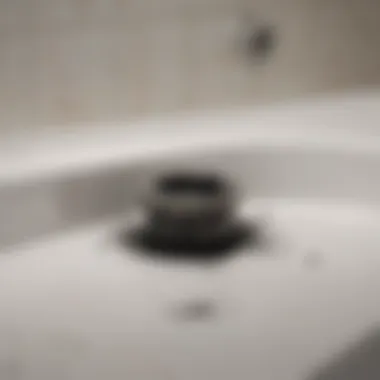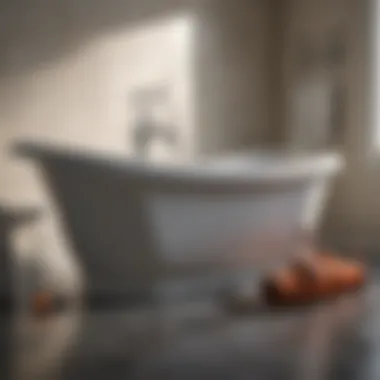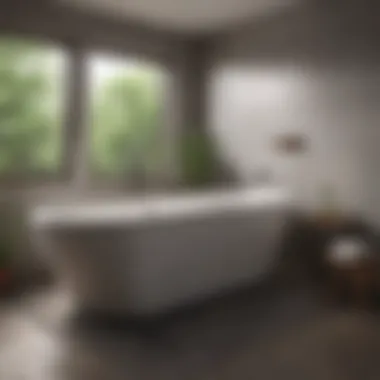Understanding Bathtub Clogs: Causes & Solutions


Intro
Bathtub clogs present a ubiquitous challenge that every homeowner encounters at some point. Understanding the causes of these blockages offers insights into preventive measures and effective solutions. As frequent bathroom users, we often overlook the essential maintenance needed to keep our pipes clear and ensure longevity in our plumbing systems. Terminology such as hair buildup, soap residue, and external debris often symbolizes years of neglect. Recognizing these common factors is the first step to overcoming the battle against clogs.
This exploration will delve deeply into the prevalent reasons for bathtub clogging and provide practical steps for removal and avoidance. No one enjoys cleaning out a clogged bathtub, yet swift action and effective strategies can significantly alleviate the concern. Keeping plumbing health in mind is essential for every homeowner, as is creating a comfortable environment at home.
Common Causes of Bathtub Clogs
Understanding the primary causes of bathtub clogs is crucial for addressing them effectively.
- Hair: Perhaps the most common culprit, hair from daily washing accumulates over time and can create impenetrable massings within the drain.
- Soap Scum: Residue from soaps and shampoos solidifies within the pipes, leading to buildup and a significant reduction in drain flow.
- Foreign Objects: Toys, toiletries, and other small items often get inadvertently washed down the drain, causing blockages.
- Hard Water Deposits: In regions prone to hard water, mineral deposits accumulate over time, narrowing the diameter of pipes.
Careful monitoring and maintenance of these pins can mitigate many problems before they evolve into severe blockages.
Solutions to Clogged Bathtubs
Addressing a clogged bathtub involves straightforward steps combined with preventative actions.
- Remove Visible Debris: Begin by checking for visible hair and debris at the surface. Often, it is as easy as pulling up clumps or debris that is accessible.
- Use a Plunger: If clogged drains do not solve with manual cleaning, utilizing a plunger can create the suction needed to dislodge materials stuck in the piping.
- Drain Cleaners: While chemical cleaners exist, caution is recommended as they can damage plumbing over time. Always follow safety instructions when employing these solutions.
- Natural Solutions: An alternative approach involves pouring a mixture of vinegar and baking soda down the drain, allowing them to sit before flushing with boiling water to help break down build-ups.
- Regular Maintenance: Cleaning your bathtub drain periodically can greatly decrease the likelihood of encountering clogs, offering a preventative measure. Using drain guards while in the shower can help to avoid problematic inflows.
Maintaining your bathtub is a design feature as well as a practical one. Regular attention can ensure that your space remains functional and attractive.
Consider these conventional troubleshooting concerns and selected preventive measures the next time untimely drainage issues arise in your home or suggested improvements for residents.
The End
Instilling a proactive maintenance routine and understanding the underlying causes of bathtub clogs will empower you against future problems. Investing time and attention today can result in significant benefits tomorrow. Bathtub clogs, while common, can become a manageable issue that aligns with your desire for a beautiful and functional home. Emphasizing maintenance, understanding key factors, and employing effective solutions transforms your bath space into a resilient asset.
Preamble
Bathtubs are essential fixtures in many homes, providing comfort and a space for relaxation. However, they come with the potential for common plumbing issues, the most prevalent being clogs. Understanding the causes of a clogged bathtub and the available solutions can help homeowners maintain better plumbing health. A clogged bathtub can lead not only to frustrating bathing experiences but also to more significant problems, including water damage and costly repairs.
Recognizing the importance of this issue is vital. It extends beyond simple inconvenience; it serves health and hygiene on a broader scale. Bathtub clogs often lead to stagnant water, which can become a breeding ground for bacteria. In addition, knowing how to tackle these clogs effectively saves time and money in the long run.
The objective of this article is to provide clarity on the factors contributing to clogged bathtubs. By highlighting everyday elements—such as hair accumulation, soap scum buildup, and foreign objects—this research makes the invisible visible. It further provides structured methods for maintenance to prevent these issues from arising. Understanding these causes and methods equips individuals with the knowledge needed to approach drainage problems confidently and efficiently.
Clearly identifying and addressing clogged bathtub conditions ensures longevity not just for plumbing, but enhances the everyday living experience as well. The following sections will explore the anatomy of a bathtub drain, common causes of clogs, and viable solutions. Homeowners and enthusiasts in the realms of maintenance and real estate should find this information particularly useful. By delving deeper into this common household challenge, one can turn a nuisance into manageable maintenance, guarding the integrity of one's home.
"An informed homeowner is an empowered homeowner."
Ultimately, the knowledge gained here is an investment in preserving the functionality and value of living spaces.
The Anatomy of a Bathtub Drain
Understanding the anatomy of a bathtub drain is essential for half-hearted plumbing interventions and successful long-term maintenance. Every component in the drain system plays a role. Mastery of these parts not only aids in the effective management of clogs but enhances the longevity of your entire plumbing system.
Bathtub drains are surprisingly intricate. The seamless operation of the drain system is vital for water flow. Recognizing how it works enriches the overall home maintenance experience. A well-maintained bathtub drain ensures time spent cleaning remains efficient rather than reactive to frequent blockages.
Components of a Bathtub Drain System
A bathtub drain system consists of several important components:
- Strainer: The visible part where water exits, crucial for catching debris and hair.
- Drain Pipe: Channels water from the tub to the main sewage or disposal line.
- P-Trap: A U-shaped pipe preventing sewer gases from surging up through the drain.
- Overflow Pipe: Prevents overflowing by rerouting excess water back into the drain.
Each part serves an eminent role, typically reaffirmed during times of blockage. Failing to understand their individual importance risks ineffective solutions, potentially leaving water standing in your bathtub.


How Water Flow Works
Knowing how water flows through this system is pivotal. Water moves down from the bathtub, propelled by gravity, entering a strainer that filters out obvious obstructions like hair or larger particles. From here, it travels through the drain pipe into the P-trap, which retains a small amount of water. This safeguard inhibits gases from the sewer from infiltrating the home.
Flow consistency necessitates a clear route. Any buildup can halt what should ideally remain fluid, creating backflow and potential damage.
Once the water clears the P-trap, it reaches the overflow pipe. This system is designed to maintain balance during tub use, but if the overflow is obstructed, it can lead to leaks or water waste. Evaluating how water moves creates a pathway for both preemptive and responsive maintenance methods.
Grasping these fundamental pieces provides clarity. Being observant of how each functions individually fosters effective validation when dealing with plumbang issues. Ensuring components of the drain remain unobstructed keeps the bathroom as a oasis, not a burden reliving plumbing issues.
Common Causes of Bathtub Clogs
Understanding the common causes of bathtub clogs is essential for dynamic plumbing management. This section addresses specific elements that frequently contribute to blockages in bathtub drains. Each cause not only highlights unique situations but also emphasizes the benefits of awareness when it comes to preventing clogs. Identifying the root cause can prompt timely action, West point thereby saving time and money in the long term.
Hair Accumulation
One of the most prevalent causes of bathtub clogs is hair accumulation. Hair strands can easily become entangled within the drain. This irritation leads to physical blockage. Regular bathing often allows hair to shed, contributing to a gradual buildup over time. Over time, even small amounts can exacerbate clogging issues. Immediate removal of hair strands during or after bathing is advisable to ensure less accumulation reaches the drain.
Soap Scum Buildup
Another significant contributor to clogs is soap scum buildup. Each time you bathe, residue from soap mixes with minerals and oils, forming a nasty compound that can stick to pipes. When combined with hair, this toxic mix tightens its grasp inside the drain, creating an almost unyielding barrier. Using liquids designed to dissolve soap scum and regular scrubbing can reduce this risk. Also, the use of less bar soap in favor of liquid options can decrease buildup.
Foreign Objects
Foreign objects in the bathtub drain pose another clgging risk. Common offenders include small items such as jewelry, small toys, or even bath products. Such objects are often accidentally dropped into the drain. When these obstruction-prone items collect in the plumbing, they can significantly impede water flow, leading to unpleasant scenarios. Implementing drain covers to catch these objects help maintain flow and avert clogs.
Mineral Deposits
Finally, mineral deposits from hard water issues can lead to severe drainage problems. The minerals present in hard water precipitate out as they move through pipes. This is especially problematic in areas with hard water. These deposits accumulate over time and harden, ultimately closing narrow passageways. To remedy this, descaling products can be beneficial at averting buildup and extending the efficiency of your plumbing system.
Impact of Clogged Bathtubs
Clogged bathtubs present significant challenges not only in terms of functionality but also in broader implications that can affect your home and health. Understanding the implications of a clog within your tub is essential for homeowners, real estate enthusiasts, and anyone concerned with the long-term wellness of their living areas.
Water Damage Risk
One of the most pressing issues related to a clogged bathtub is the potential for water damage. When water is unable to drain as intended, it accumulates, leading to several risks including:
- Structural Damage: Prolonged exposure to water can weaken flooring, walls, and even the foundation of your house. In particular, wood structures become vulnerable to rot and insects like termites.
- Mold Growth: Moist environments are breeding grounds for mold. When water stagnates, mold can grow rapidly, creating health risks for residents.
- Increased Repair Costs: It can be costly to address water damage. Repairing structural components and eliminating mold can often require items, such as professional intervention, leading to significant expenses.
To emphasize the seriousness of this issue, keeping your bathtub drain clear should be a priority. Preventive actions will greatly reduce the risk of water damage associated with clogs.
Health and Hygiene Concerns
The health ramifications of a clogged bathtub are also noteworthy. Standing water collects not only grime and soap scum but also becomes a potential breeding ground for various pests and bacteria. Key considerations include:
- Bacterial Infections: Dirty, standing water is typically rich in bacterial colonies which may cause infections. Next time you step into a bath, awareness of the cleanliness of the water becomes crucial.
- Allergies and Respiratory Issues: Mold, often linked to water damage, can trigger allergic reactions and respiratory issues in sensitive individuals, adding an extra layer of risk to clogged tubs.
- Overall Hygiene: The bathtub is an intrinsic part of personal hygiene. A clogged drain hinders your ability to take a restorative bath, influencing the daily routines that are essential for well-being.
Preventive Measures
Preventive measures in managing bathtub clogs are vital. This approach encourages a proactive mindset towards plumbing issues. They help to reduce both the frequency of clogs and the potential costs related to plumbing maintenance. Implementing simple practices can save time and frustration.
Moreover, preventive efforts help maintain the overall health of your bathtub drain system. Regular implementation of these measures ensures smooth water flow and prevents buildup of various clogging agents. The longer a clog remains, the harder it is to remove. Therefore, proactively addressing clog issues is key.
Every homeowner should prioritize understanding the specific elements associated with prevention. These include using drain covers and adhering to routine maintenance practices. Such strategies not only protect plumbing systems but also enhance the user experience of the bathtub itself.
“An ounce of prevention is worth a pound of cure.”
It's an often quoted truth that rings especially relevant when dealing with plumbing. Taking small steps today can prevent larger issues tomorrow.


Using Drain Covers
Utilizing drain covers is one of the simplest yet most effective methods to prevent Bathtub clogs. These covers catch items that may inadvertently fall into the drain. For instance, hair, soap remnants, and small objects can go unimpeded without a cover. Thus, preventing significant buildup becomes easier with this single addition.
Choose drain covers that are easy to clean and suited to the bathtub design you have. Frequent cleaning should be a part of the experience for staying proactive about clogs. If hair accumulates on the cover, it can clog up the water flow rather quickly. A quick rinse or shake can remove these nuisances.
Consider the following when selecting and using drain covers:
- Size and Fit: Ensure a snug fit to avoid any debris slipping underneath.
- Material: Opt for durable materials, able to withstand placement and removal over time.
- Style: Choose options that harmonize with bathroom aesthetics while remaining functional.
Regular Maintenance Practices
Regular maintenance of the bathtub drain ensures the system operates efficiently. This maintenance is often overlooked but is crucial in preventing buildup that can lead to clogs. Simple steps can deter problem development while providing you peace of mind.
Some basic practices include:
- Free Water Flow Inspection: Periodically check that water flows freely without slowdowns. This can highlight issues before they escalate.
- Use Soft Cleaners: Harsh chemical cleaners can damage pipelines. Instead, bet on personalized recipes with natural cleaners, such as baking soda or vinegar.
- Perform a Drain Cleaning: Once a month, run boiling water through the drain to clear minor buildups of debris. Alternatively, a mixture of vinegar and baking soda may also be effective.
Developing these regular habits greatly benefits the lifespan of your plumbing. Aots of problems can be deterred simply by doing Follow-through on small tasks. These habits can lead to significantly less daunting plumbing concerns later.
DIY Solutions for Unclogging Bathtubs
DIY solutions provide effective and often cost-efficient methods for tackling tub clogs. These strategies enable homeowners to address minor blockages without resorting to outside help. Understanding various techniques for unclogging a bathtub can save time and prevent escalating plumbing issues.
Utilizing do-it-yourself methods allows for immediate interventions, which can ease discomfort and restore normal usage of the bathtub efficiently. The processes outlined are straightforward, requiring minimal tools and easily accessible household items.
When tackling clogs at home, keep in mind several benefits:
- Cost savings compared to hiring professionals.
- Gaining knowledge on plumbing systems.
- Experiencing a rewarding sense of accomplishment.
However, it's essential to consider factors like the severity of the clog. If the blockage appears severe or stubborn, these recommend methods might not yield results.
Plunger Method
The plunger method is among the most straightforward techniques used to clear a clog. It's especially effective for relatively loose obstructions like hair or soap scum. Here's how to apply this method:
- Choose the right plunger. For bathtubs, a flange plunger is ideal as it seals better around the drain.
- Position the plunger over the drain hole. Make sure there is enough water in the tub to cover the plunger.
- Create a firm seal. Press down on the plunger and then pull upwards swiftly. Repeat this action several times.
- Rinse the drain with water to check for any remaining blockage.
"Using a plunger can be very effective if done right, and it often really does work on minor clogs."
Using Baking Soda and Vinegar
Combining baking soda and vinegar not only deodorizes the drain but also creates a fizzy reaction that can help break up clogs. This method is non-toxic and environmentally friendly. To carry out this technique, follow these steps:
- Measure one cup of baking soda and pour it directly into the drain.
- Follow with one cup of vinegar. This will react with the baking soda, creating bubbles that push through the clog.
- Cover the drain with a stopper or cloth. This prevents the fizz from foaming out.
- Wait for about thirty minutes. After setting, flush the drain with hot water.
This method is simple but effective and provides an excellent backup solution if other techniques fail.
Snake Tools Utilization
A plumbing snake or auger is a valuable tool for persistent clogs. It's a long, flexible device that reaches deeper clogs that other methods might miss. Here’s how to use it:
- Loosen the drain cover and carefully remove it to access the drain.
- Insert the snake slowly into the drain until you encounter resistance.
- Rotate or push the snake gently to break up or capture the clog.
- Pull the clog back and remove it from the snake once it grips it well.
- Run hot water down the drain to clear any remaining debris.
Both effective and thorough, utilizing a snake can make a noteworthy difference for stubborn blockages that require a little extra effort. Utilizing these DIY techniques will enhance one's understanding of plumbing dynamics while enabling effective problem-solving.
Professional Intervention


When a bathtub clog proves to be too resilient for DIY solutions, professional intervention becomes crucial. Hiring a plumber may often seem like a cost-inhibited decision; however, understanding its benefits and timing can save frustration and potential damage. It is wise to consider professional assistance especially when faced with stubborn clogs or recurring issues. Professionals bring not only expertise, but also specialized tools and techniques that can efficently restore normal bathroom function.
Main advantages include:
- Efficient Diagnosis: Professionals can quickly identify underlying issues beyond visible clogs, such as broken pipes or improper venting.
- Proper Tools: Whether it’s a high-pressure water jet or an advanced plumbing snake, their tools are designed for effective and safe clearing of the obstruction.
- Long-term Solutions: Professionals can offer advice to prevent future issues based on their findings, ensuring you have strategies for ongoing maintenance.
Professional intervention also provides assurances about the work completed. Mismanaged DIY efforts can not only exacerbate the situation but can lead to further costs in repairs.
When to Call a Plumber
Recognizing when to call a professional is essential. If traditional techniques such as plunging, using baking soda and vinegar, or snake tools have failed after a reasonable number of attempts, it is time to reach out to a plumber. Additionally, certain conditions signal the need for expert assistance:
- Recurring clogs that happen often, indicating a systemic problem.
- Unpleasant odors that persist regardless of cleanup efforts, possible signs of a deeper blockage.
- Gurgling or bubbling sounds when using other fixtures, which can indicate venting issues and not just a clogged bathtub.
- Visible leaks or water pooling around other plumbing units, suggesting the risks of water damage elsewhere in your home.
Deciding to call a professional early on often prevents more expensive repairs down the line. Ignoring clear signs of plumbing issues can result in mold, serious water damage, and costly renovations.
What to Expect from a Professional Service
If you've decided to call a plumber, it's beneficial to know what to expect. Professional plumbing services typically involve several strategic steps to address your issue efficiently:
- Assessment: The plumber will begin with an assessment of the situation, checking for complaints, cues indicating leaks, or signs of previous work.
- Diagnosis: Once clear, the next step is pinpointing the exact cause of the clog. This often involves manual reviews and potentially utilizing video cameras to inspect pipes more thoroughly.
- Action: After arriving at a conclusions they will provide explanation and suggestions - ranging from minor drain clearing to suggested pipe replacements if necessary.
- Follow Up Recommendations: A reliable plumber won’t just fix the immediate concern. They will often leave you with recommendations for regular maintenance or changes to improve drainage efficacy moving forward.
To summarize, engaging the services of a professional not only clears the existing obstruction efficiently but sets up preventive measures to alleviate future issues.
'A stitch in time saves nine.' - in plumbing, this encourages proactive early intervention, thus prolonging both plumbing lifespan and efficiency.
Always aim for qualified professionals and seek out credible reviews and recommendations, focusing on value over the simplest solution for your property’s health. Understanding the plumbing landscape adds another layer to your home maintenance skill set.
Cost Implications
Assessing the cost implications surrounding a clogged bathtub is vital. Understanding the financial aspects empowers homeowners to make informed choices. The costs can vary widely based on the method selected for resolving clogs.
DIY vs.
Professional Costs
Deciding between a DIY approach and hiring a professional has significant financial consequences. With a DIY method, the costs are generally lower. For instance, tools like plungers or drain snakes can total under fifty dollars. In case of a clog caused by minor issues, such as hair or soap residue, this choice can save both time and money.
However, when challenges escalate, like foreign objects deeply lodged, the cost for unsuccessful DIY attempts potentially increaes. Accidental damage from improper techniques could lead to plumbing repairs. Repairing damaged pipes could result in expenses reaching hundreds of dollars.
By contrast, professional plumbing services tend to have a higher initial cost, often falling within the range of seventy to two hundred dollars per visit. Yet, hiring specialists usually ensures quick and efficient resolution. Technicians possess the expertise to tackle complex blockages safely and might provide long-term assistance to prevent future issues. While this requires a larger upfront investment, it can lessen higher costs repeatedly associated with DIY misadventures.
Long-term Financial Impacts
The long-term financial implications of clog mismanagement deserve consideration. Persistently neglected issues often escalate, resulting in more serious plumbing problems. Failing to resolve a clog quickly can lead to water damage, necessitating costly repairs to walls and floors, often exceeding thousands of dollars.
Moreover, if plumbing problems arise, consider potential maintainance fees. Properties with repeated clogs may require more extensive inspections over time. Preventing these problems resonates far more financially sound than addressing ongoing repairs.
Investing time and effort into proper maintenance is significantly more cost-effective than dealing with aftereffects of neglect.
The End
By learning about preventive measures, readers can create a sustainable routine to minimize the occurrence of clogs, ensuring proper drainage and functionality of their bathtubs. Knowledge of DIY solutions offers practical pathways for immediate relief, while understanding when to call a plumber could spare further issues down the line.
Cost implications discussed also illuminate the choice between DIY methods and professional services, highlighting the economic considerations of plumbing maintenance.
Overall, implementing these insights fosters an environment of proactive care in home upkeep and adds long-ter health to plumbing systems. The topics discussed not only serve immediate needs but also reinforce the importance of ongoing awareness and management of household systems, preserving the integrity of living spaces for years to come.
Effective maintenance reduces long-term costs and enhances daily comfort.
For further insight, readers are encouraged to continue exploring related topics in plumbing health at sources like Wikipedia) and Britannica.
By synthesizing these elements, this article provides a comprehensive examination of bathtub clogs, encapsulating the significance of informed actions in sustaining quality home environments.



